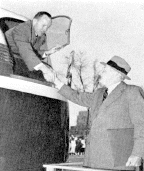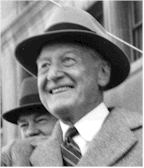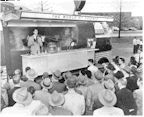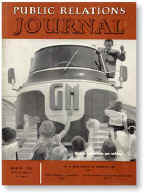|
YOU MAY ALREADY
have seen the big red-and-silver Parade caravan rolling along the
highways.
Perhaps you also have watched the Parade in action
-- at a show site in one of the communities it has visited this year.
If so, you know that the Parade is aimed straight at "the grass
roots."
The approach: direct, personal -- and
dramatic.
The philosophy: Here's how it was recently
summed up by GM's president, Harlow H. Curtice:

GM President, Harlow Curtice
shakes the hand of Parade Director John Ryan. |
 HARLOW H.
CURTICE, GM's PRESIDENT HARLOW H.
CURTICE, GM's PRESIDENT
"We want to help folks see, specifically, how
research, engineering, and American progress are solidly linked
together.
"And we want, too, to inspire young people --
the youngsters with eyes on the future, the inventors, the scientists,
engineers, and leaders of tomorrow.
"In short we hope to present, through this
Parade of Progress, a picture of America on the move toward better
lives for all of us."
|
FREE EXHIBITION
The Parade of Progress is thus a free, traveling
exhibition. It is probably the largest show of its kind ever
undertaken. It carries its own 1,250-seat Aer-O-Dome "big top"
and will be on tour indefinitely.
Along with the Parade's basically inspirational
theme, the project naturally is expected to influence people favorably
toward General Motors as a leading company devoted to making
"more and better things for more people." Essentially,
however, this is an industrial story.
The entire project, an investment of several
million dollars, is directed by the GM Public Relations Staff, under
Paul Garrett, vice president. He has amplified the PR thinking behind
the Parade's glitter and glamour in these words:
PAUL GARRETT, VICE PRESIDENT
"The 55 young men now starting across the
country (as the staff that operates the caravan) are to become Ambassadors-at-Large
not only for General Motors but for our American way of achieving
economic progress. These trained young men will bring a dramatic story
of American industry to towns in all parts of the land.
"We want our audiences to understand how this
progress has been achieved -- in other words, the role played by
science, by research, by engineering -- backed up by an economic and
political system that over the long run has given people freedom to
think, create, and compete, and has rewarded those who make better
products and help people live better."
ACROSS THE COUNTRY
 With that goal, the "caravan of science"
will criss-cross the entire country, and perhaps visit a few of our
neighboring countries. It will stop for stands of from a few days to
perhaps two weeks in hundreds of the nation's communities.
With that goal, the "caravan of science"
will criss-cross the entire country, and perhaps visit a few of our
neighboring countries. It will stop for stands of from a few days to
perhaps two weeks in hundreds of the nation's communities.
The New Parade began to roll in April, 1953. First
came rehearsals in Lexington and Frankfort, Ky. Then came a world
premiere in Dayton, Ohio, for press-radio-TV and civic leaders,
followed by a highly successful public showing that attracted more
than 92,000 people. Since then, the Parade has moved on to other
cities in Ohio, Indiana, and Michigan. In the fall, the Parade headed
south.
Charles F. Kettering, famous scientist, and former
GM research chief, who sparked the idea for the original Parade of
Progress, describes the Parade's travels thus:
CHARLES F. KETTERING
"This is not a selling campaign. We are not
trying to sell anything but our country to our citizens."
The Parade has taken science and industry out of
the laboratory and factory and put them on the stage. It explains the
challenges -- and its audience is people throughout the land.
It is public relations on wheels.
What are the public relations problems and
techniques in such a project?
PARADE BACKGROUND
The original Parade took to the road in 1936 in
Lakeland, Fla. It was far from today's streamlined version, but its
purpose was identical. During the six years to December, 1941, the
caravan played to audiences of more than 12 million people in 251
cities.
In 1940, the original show was expanded and
improved. The Parade's first orthodox "big top" -- jokingly
labeled a "Queen of Sheba tent" by Kettering -- was replaced
with a unique show place -- the Aer-O-Dome tent, designed by GM people.
The Aer-O-Dome, now one of the features of the Parade, has an aluminum
framework on the outside. From this frame hangs a silver-colored,
fireproof, plastic-and-canvas skin. Thus there are no poles, no wires
to block your view as you watch the state presentation.
After Pearl Harbor the Parade went into storage.
But last year, GM officials decided the time had come to put a new
Parade on the highways. For in recent years great new developments in
science and industry have stirred the popular imagination --
television, radar, jet power.
PHYSICALLY, THE PARADE HAS:
 44 vehicles, including 12 Futurliners, or special exhibit
vans. Each Futurliner is 33 feet long and has 16-foot sides that open
to form exhibit areas or stages. In addition to the
"liners," there are 14 trucks and 18 cars.
44 vehicles, including 12 Futurliners, or special exhibit
vans. Each Futurliner is 33 feet long and has 16-foot sides that open
to form exhibit areas or stages. In addition to the
"liners," there are 14 trucks and 18 cars.
The Aer-O-Dome tent, in which a
40-minute stage show of science is presented six to eight times a day,
seven days a week, while the Parade is in town.
A Theme Center, or combination
entrance point and information area.
The men who operate the parade are mostly college
trained or with special technical knowledge acquired in industry and
the armed services. These young men are at once lectures,
"roustabouts," and truck-drivers. They stage the shows give
the talks, set up the tent, and do all the work to keep the caravan on
the move. They have been carefully selected, and are a part of the GM
public relations department.
PUBLIC RELATIONS
As you can see, from a professional public
relations viewpoint, the parade has a number of interesting aspects:
First, there are the techniques of
advancing the show, putting it on, and following it up.
Second, there are the usual problems
of any such enterprise -- except that this is an educational project
with unusual public relations overtones.
Third, there is the public reaction.
This is the key point.
To begin, let's see how the way is paved for the
parade
ADVANCE PR COVERAGE
This job falls to the Parade's advance men, GM
public relations regional managers, and a Parade committee of Local GM
people. The Parade has four advance men. Each works a city at a time.
His chores: newspaper, radio-TV coverage, promotion via advertising
and signs, lot selection, hotel reservations, routing, and so on.
Working closely with him in each town is the GM
regional PR manager, of whom there are 11 in the country. The regional
manager knows his area well. And he helps the advance man with the
hundred-and-one physical and personnel arrangements that have to be
made.
Each advance man has a 69-page manual, to guide
him. It has sections, for example, on news, advertising, and what to
do on each visit to town. These duties range from getting garage
accommodations to providing for police escorts.
About two weeks before the caravan arrives, the
advance man begins his intensive news and advertising program. To aid
the advance man in his news work, the public relations staff in
Detroit prepared such materials as a story kit, a picture file, and
movies. These give the advance man information that he can use
"as is" or fit to the locality.
The advance man constantly keeps the press, radio,
and TV informed on Parade attendance, human interest and spot news
stories. He gives Press Handbooks, 39 printed pages, to all staffers
needing them. Using his picture file, the advance man also supplies
editors with advance glossy prints or mats. He has movie material for
service clubs and TV.
Advertising -- for newspaper, radio, and television
-- is largely handled through an agency, but the advance man keeps in
touch will all media.
In addition to his work with the press, the advance
man enlists the cooperation of all GM dealers in the community. This
has proven to be extremely helpful.
GM plants also have helped greatly. Most of the
cities visited this year have had GM plants. Why this route? First, to
give GM folks a chance to see the Parade early; second, to help
develop public relations thinking throughout the GM family --
including, of course, GM's dealers.
An example of how this works: the plants send out
personal invitations to every GM employee's family to attend the
Parade. And dealers have joined in many kinds of Parade promotion:
display ads, direct mail, posters, signs, show room displays. In all,
therefore, the Parade is boomed as vigorously as possible -- as an
educational but highly entertaining show for the whole family to see.
THE SHOW HITS THE TOWN
 Finally, the big day -- the show hits town. The Futurliners, gleaming
in the sun (the advance man prays), roll slowly along the streets as
crowds watch this new kind of caravan wind its way to the show lot.
Finally, the big day -- the show hits town. The Futurliners, gleaming
in the sun (the advance man prays), roll slowly along the streets as
crowds watch this new kind of caravan wind its way to the show lot.
There, the work of setting up the Aer-O-Dome tent and
preparing the exhibits in the Futurliners draws much attention -- from
youngsters and grownups alike.
Next comes the invitational "preview."
This is held from 7-10 p.m. the day before the Parade opens to the
public. Guests, from 1,500 to 3,000 in number usually, are the
community's "thought leaders" and their families.
Guests are first welcomed by a General Motors
representative who is the top local GM executive. Then the mayor or
other high local official usually speaks briefly. In the main talk of
the evening, a GM executive from Detroit speaks of the Parade and its
purposes. next, the stage show is presented.
Now, let's look at some other public relations
aspects of the Parade of Progress. Naturally, the personnel of the
caravan are instructed to act well in their role as PR ambassadors.
They must be gentlemen personally and good PR men officially -- in how
they drive their bright red cars around town, in how they deal with
hotel people, in all their relationships with Hometown.
But probably the most important public relations
problem is how the show itself is presented.
Here the effort has been to keep the show on an
institutional plane. Some exhibits, for example, deal with
transportation in a board sense -- on the ground, in the air, at see.
Others concern progress in life on a farm. Still others take up
various aspects of modern engineering.
GM people who have worked with the show for months
point out, moreover, that "progress" is part of the Parade
itself. Changes are made constantly. Acts are improved. Scripts are
reworded. Signs and labels are modified. New exhibits are added,
others removed.
Always there is the challenge to make the show
better.
PUBLIC REACTION
Now the payoff question: What has the
public reaction been?
In some cities, crowds have totaled more than the
within-city-limits population -- a tribute to the drawing power
through the trading area. In fact, in the first three months of
operations, attendance topped half a million people. The total rose to
almost 1,115,000 after the Parade finished its stand at the Michigan
State Fair in Detroit in the fall and is now approaching the two
million mark.
Yes, crowds stand and listen intently to the young
lecturers as they tell and show basic principles of physics and
chemistry, under such titles as "Word of Science," and
"Miracles of Heat and Cold."
People chuckle, then guffaw, as "Old
Scout" chugs and shakes. This car, a 1902 Oldsmobile, still runs
merrily along, as it did in winning the first transcontinental race in
1905 in 44 days -- and the crowds love the whole line of patter that
goes with the act!
They stand fascinated, too, at "American
Crossroads," a complex, animated sound exhibit that shows the
country growing 50 years in 10 minutes.
They marvel at a modern jet engine, cut apart so
you can see how and why it works, while a young man explains it all.
The Parade, it seems, is a smash hit. What's more,
it is helping adult American appreciate the nation's great heritage,
and is inspiring young America to build even greater for the future.
|
 Public
Relations on Wheels
Public
Relations on Wheels The following was taken
from the March, 1954 publication "Public Relations Journal".
The author of the article was Robert S. Johnson, a member of GM's PR
staff in Detroit. His credentials read: "... he has been in
newspaper and PR work since 1938. He was formerly associated with
"The Wisconsin State Journal," Rochester
"Times-Union," and the AP Buffalo and Albany bureaus. During
World War II he was in Navy PR and air intelligence, on shore and
aboard carriers. He also spent years in Eastman Kodak's PR department.
The following was taken
from the March, 1954 publication "Public Relations Journal".
The author of the article was Robert S. Johnson, a member of GM's PR
staff in Detroit. His credentials read: "... he has been in
newspaper and PR work since 1938. He was formerly associated with
"The Wisconsin State Journal," Rochester
"Times-Union," and the AP Buffalo and Albany bureaus. During
World War II he was in Navy PR and air intelligence, on shore and
aboard carriers. He also spent years in Eastman Kodak's PR department.
 HARLOW H.
CURTICE, GM's PRESIDENT
HARLOW H.
CURTICE, GM's PRESIDENT With that goal, the "caravan of science"
will criss-cross the entire country, and perhaps visit a few of our
neighboring countries. It will stop for stands of from a few days to
perhaps two weeks in hundreds of the nation's communities.
With that goal, the "caravan of science"
will criss-cross the entire country, and perhaps visit a few of our
neighboring countries. It will stop for stands of from a few days to
perhaps two weeks in hundreds of the nation's communities. 44 vehicles, including 12 Futurliners, or special exhibit
vans. Each Futurliner is 33 feet long and has 16-foot sides that open
to form exhibit areas or stages. In addition to the
"liners," there are 14 trucks and 18 cars.
44 vehicles, including 12 Futurliners, or special exhibit
vans. Each Futurliner is 33 feet long and has 16-foot sides that open
to form exhibit areas or stages. In addition to the
"liners," there are 14 trucks and 18 cars. Finally, the big day -- the show hits town. The Futurliners, gleaming
in the sun (the advance man prays), roll slowly along the streets as
crowds watch this new kind of caravan wind its way to the show lot.
Finally, the big day -- the show hits town. The Futurliners, gleaming
in the sun (the advance man prays), roll slowly along the streets as
crowds watch this new kind of caravan wind its way to the show lot.